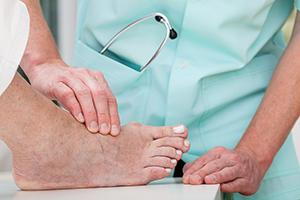Don’t let a bunion lead to chronic foot pain. Learn how to manage your symptoms.
Do you find yourself rubbing a rather hard bony lump near your big toe? If so, then you might have a bunion. While anyone can develop  bunions, women are more likely to develop this foot deformity. Blame genetics, or blame those high heels that you wear everyday to work; however, there are ways to prevent this problem from getting worse. From the office of our Asheville, NC, podiatrist Dr. Daniel Waldman, discover some ways to reduce bunion pain and swelling.
bunions, women are more likely to develop this foot deformity. Blame genetics, or blame those high heels that you wear everyday to work; however, there are ways to prevent this problem from getting worse. From the office of our Asheville, NC, podiatrist Dr. Daniel Waldman, discover some ways to reduce bunion pain and swelling.
How do I know that I have a bunion?
While a bunion can develop on just about any joint in the foot, it most often affects the big joint at the base of the big toe. Take a moment to examine your feet. Stand up straight and look at the curve and appearance of both feet. If you notice that one or both feet have a bony protrusion sticking out from the base of the big toe and that your big toe has started to lean in on the smaller toes then you could have the beginnings of a bunion.
Bunions, particularly early on, don’t always cause symptoms. This deformity develops gradually over time and can be exacerbated by wearing poorly fitted shoes or high heels, which put unnecessary pressure on the joint. If you are starting to experience inflammation or pain in that area, particularly when walking around then it’s time to visit your Asheville, NC, foot doctor to find out whether it’s the result of a bunion or if something else is going on.
How do I treat a bunion?
Since this deformity is progressive the goal for treatment is to prevent the bunion from getting worse. The only way to get rid of a bunion is through surgery; however, surgery is usually the very last treatment option to consider and is only recommended when other treatment options have failed to provide relief. But you’ll be happy to know that bunions can easily be managed with simple, everyday measures such as:
- Wearing supportive, properly fitted shoes
- Applying a protective non-medicated pad over the bunion before wearing shoes
- Wearing a splint, which can realign the foot and take pressure off the bunion
- Placing custom orthotics into your shoes for further support and stabilization
Do you want to know whether your foot problems could be the result of a bunion? Want to learn more about the ways we can help you manage your bunion symptoms? Then it’s the perfect time to turn to Dr. Waldman at Blue Ridge Foot Centers in Asheville, NC. Dr. Waldman is board certified and also teaches surgery nationally and internationally including the latest Minimal incision. Call our office today at 828-254-5371 or visit https://www.blueridgefoot.com/.
